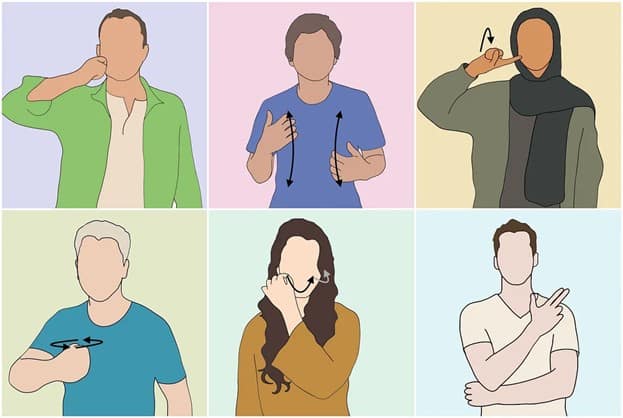We all know certain people by a nick name or preferred name. Sometimes this is because we know more than one person by that name, sometimes it is something to do with them which caused them to be dubbed by another name and better known for that. Some men named Jack might be called John for example or famous people have assumed a name like Madonna or Symbol.
So, what are sign names? Are they nick names? Not necessarily no. Sign names are a visual sign name for a person. Often it will be after something they are known for – for example “tall”; “football”; “eyebrows” (someone who is expressive or, well, has big eyebrows); “walking stick”; or “lipstick”.
Why do we use sign names? Well, by now you are probably mastering the complexities of finger spelling on two hands and you will find with practice that you can get quite speedy. The problem is it gets a bit laborious to fingerspell names repeatedly, especially when you are speaking about someone who is familiar to you and who you are talking to at the time. Also sometimes misunderstandings can occur, even between native BSL users, which means things have to be repeated. So it is much quicker to sign one word. This may sound odd to you as hearing people, but it is something we as Deaf people do ALL the time.
Here is a written translation of a BSL conversation where use of sign names would commonly occur:
“I was at Deaf Club last Saturday and “Limp” (John) was telling me that ‘Curly Hair’ (Janet who has really curly hair) is having another baby but she hasn’t told “Red” (Diane who has red hair) yet so please don’t say anything!!”
“Are you serious?! I saw ‘Curly Hair’ (Janet) yesterday and she never said! Wow, ‘Red’ (Diane) will hate being the last to know!”
When we sign the ‘sign name’ we use lip pattern to say the name of the person. So when signing ‘Limp’ you would mouth the name “John”; ‘Curly Hair’ would be “Janet” and ‘Red’, “Diane” and so on. You do not need to explain why the person has the sign name unless the other person does not know them. An example of a conversation where the other person does not know who you mean would be as in the below example:
“Hey, did you know that ‘Curly Hair’ (Janet) is having another baby?!”
“A baby?? Who is ‘Curly Hair’? Do you mean ‘Red’ (Diane)? She has hair that is a bit curly and red?”
“No! Not ‘Red’ (Diane) – ‘Curly Hair’, you know the lady that has lots and lots of curly hair, her name is ‘J-A-N-E-T’ and married to ‘Limp’ (John).”
“Oh yes, I know ‘Limp’ (John) – wow they are having a baby! His wife is beautiful and so slim. Wow, she is having a baby, how exciting.”
In summary using a sign name for a person makes the exchange much less formal and more familiar. It is remarkably similar to using a nickname, but unlike hearing people, most Deaf people have their own “name”. Using a sign name also this makes it quicker when conversing and referring to other people.

Sign names are often given by a Deaf person because we are very quick to notice peculiarities or it can be something you create yourself. My sign names for example include “S-H” for my initials and “Tall” which describes my height. When I am teaching on Zoom it is useful if my students have sign names as it saves confusion with fingerspelling – not to mention the time saved too!

I hope you have found this blog useful. I would love to hear your comments and questions.
LINKS:
